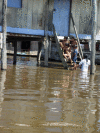Commentary: improving the health of neglected populations in Latin America
- PMID: 17244369
- PMCID: PMC1784084
- DOI: 10.1186/1471-2458-7-11
Commentary: improving the health of neglected populations in Latin America
Abstract
Neglected diseases encompass a group of pathologies that disproportionally affect resource-constrained areas of the world. In tropical and subtropical areas in Latin America, the vicious cycle of poverty, disease and underdevelopment is widespread. The burden of disease associated to neglected diseases in this region is mainly expressed through diseases such as malaria, dengue, intestinal parasitic infections, Chagas' disease, and many others. These maladies have burdened Latin America throughout centuries and have directly influenced their ability to develop and become competitive societies in the current climate of globalization. Therefore, the need for a new paradigm that integrates various public health policies, programs, and a strategy with the collaboration of all responsible sectors is long overdue. In this regard, innovative approaches are required to ensure the availability of low-cost, simple, sustainable, and locally acceptable strategies to improve the health of neglected populations to prevent, control, and potentially eliminate neglected diseases. Improving the health of these forgotten populations will place them in an environment more conducive to development and will likely contribute significantly to the achievement of the Millennium Development Goals in this area of the globe.
Figures

References
-
- Sen A. Development as freedom. First. Random House Inc, New York; 1999.
-
- Farmer PE. Pathologies of power. Health, human rights, and the new war on the poor. University of California Press. Berkeley, California; 2003.
-
- Marmot M. Social determinants of health inequalities. Lancet. 2006;365:1099–1104. - PubMed
Publication types
MeSH terms
LinkOut - more resources
Full Text Sources
Medical

